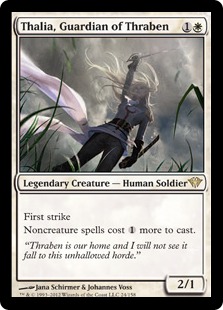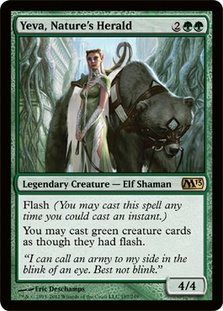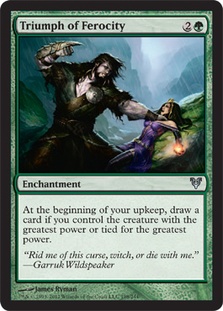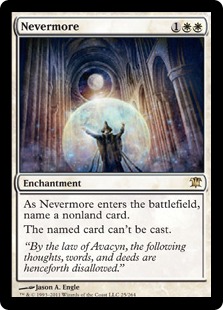Contrary to appearances, I don’t set out to play green and white in every format. It’s like there’s some kind of conspiracy at Wizards to keep me hooked on it—they keep printing all of these sweet green and white creatures and then printing all of these other cards for everyone else to play that those creatures are good against!
Going into Grand Prix Charleston, it was clear that U/W Flash was going to be the deck to beat. Even if it wasn’t the most popular deck in the room, it was going to be the most played deck among top players. It’s just the sort of deck that many pros and aspiring pros like to play, packed to the brim with spells that allow them to control the flow of the game and eke out little advantages.
I hear the same kind of argument for playing these decks all the time. “I want to play a deck that gives me opportunities to outplay my opponent!” You know what else does that? Virtually every deck in Magic! You don’t have to be playing with a pile of blue instants in order to win games based on the decisions that you make. Now, it’s certainly true that playing a deck with a lot of spells can frequently give you an edge over less experienced players who won’t play around them. If your opponents are going to attack with all of their creatures or cast all of their spells into your open mana every turn no matter what, then of course cards like Unsummon and Azorious Charm and Syncopate are going to overperform against them.
But are they who you’re really worried about beating? Magic is a hard game, and unless you’re playing something like Belcher, you’re going to win and lose by making better and worse choices than your opponent. And yet there’s this notion that good players are the ones who play control decks. Thankfully, I’ve made a career out of beating those kinds of decks.
One of the absolute best cards in Magic against people who want to feel clever is Thalia. All those cheap instants start to look a whole lot worse with an extra mana tacked on to their cost. Thalia was outstanding in the previous Standard format even when Delver decks had Gut Shot to kill her, and nowadays people are relying on Unsummon and Azorious Charm, which just give them a temporary reprieve. Thalia is even good against the non-blue decks in the format. Reanimator decks are packed with cheap spells they need to cast on time to operate properly, and token decks really hate when Lingering Souls costs seven mana to play and flashback. Even the aggressive decks like Mono-Red Aggro and Zombies match up poorly against a 2/1 first strike body that makes their removal more expensive.
So I knew I was playing Thalia—the real question was what the other 56 cards would be. As my articles on Standard recently discussed, I tried a number of midrange decks with Trostani and Armada Wurm but found that they were just a bit too slow to really capitalize on the squeeze Thalia put on my opponents. Additionally, with so many decks topping off with Angel of Serenity, it didn’t feel like I wanted to put myself in the position of playing my sixes into their sevens. I needed to go faster or go bigger.
This is a general principle I tend to abide by in deck construction. Strategically, you want to position what you’re doing to be either much faster or slightly slower and more powerful than what your opponent is doing. Frank Karsten wrote an excellent explanation of this idea in his coverage of GP Bochum when discussing Thragtusk:
“Let us consider an imaginary format where one has to choose a number X and play the corresponding deck filled with only lands and X/X creatures for X mana. In such a format, a deck with only 5/5s for five mana will lose to a blazingly fast deck with only 1/1s for one mana. The 5/5 deck will also lose to a slightly slower deck with only 6/6s for six mana. But the 5/5 deck will beat a deck filled with 4/4s for four mana and a deck containing only 8/8s for eight mana.”
That’s obviously an oversimplification, but it’s a good illustration of an important concept to keep in mind when building decks. It’s why you don’t want to be the Zoo deck in a field full of Jund or the Vengevine deck in a room full of Primeval Titans. I tend to err on the side of going bigger, but in this case it was pretty difficult since Angel of Serenity is hard to top.
It’s worth noting that this is exactly what Brad Nelson Hoof deck did. In a world of Thragtusks and Angels, he realized that he could just go way over the top by killing them in a single turn with Craterhoof Behemoth. Forget playing the attrition game that defines the midrange mirrors. He put himself in the remarkable position of winning the arms race against opposing seven-drops by playing the eight-drop Beast himself. A perfect example of this theory in action.
For my part, I decided to focus on aggression. I wanted to maximize the strength of my Thalias, and to do that I needed to put pressure on my opponent. The impact of Thalia on the game is much higher on turn 2 than on turn 12. I wasn’t a big fan of most of the G/W Aggro lists that I saw online, though, so I built my own.
The card that I cut first from the Magic Online G/W lists was Rancor. I talked a bit in my previous articles about how I’m not a big fan of Rancor, and the rise of U/W Flash helped solidify that position. Not only is Rancor not nearly as impressive a card as it once was thanks to creatures being more efficient, but it also matches up incredibly poorly against Unsummon and Azorius Charm. Why do you want Rancor if not to better apply pressure against control, and why would you play it at all if it’s weak against the most popular control deck in the format? It’s true that Rancor is a powerful effect against decks with Lingering Souls, but I felt like the number of Lingering Souls in the tournament would be vastly outstripped by the number of Azorius Charms, which made Rancor rather unexciting to me.
I was not a fan of Champion of the Parish decks for similar reasons. G/W Human decks typically end up investing a lot of time and resources in growing a large Champion, and that didn’t seem like the place I wanted to be in a world full of bounce spells. Champion is an awkward draw past the first few turns of the game, and that’s exactly what happens to it in a format full of Azorius Charms. I do think that there’s some merit to the ultra-aggressive G/W build with Champion and Rancor, as played by Sam Black to a ninth place finish, but it didn’t seem like where I wanted to be. I felt like I could get similar results against control decks with a version playing more individually powerful cards simply due to the strength of Thalia.
With that in mind, here’s what I played:
Creatures (32)
- 4 Arbor Elf
- 4 Avacyn's Pilgrim
- 4 Thalia, Guardian of Thraben
- 3 Restoration Angel
- 4 Silverblade Paladin
- 4 Wolfir Silverheart
- 1 Wolfir Avenger
- 2 Ulvenwald Tracker
- 2 Yeva, Nature's Herald
- 4 Loxodon Smiter
Lands (11)
Spells (17)

My overall record in the tournament was 12-3, with my losses coming at the hands of Bant Control, U/W Flash, and W/R Humans. I beat four U/W Flash decks, a Bant Control deck, G/W, Junk, B/R Zombies, and Mono-Red Aggro. I generally felt good about all of the matchups I played with the exception of Bant Control, which seemed quite difficult (albeit winnable). The combination of ramp, Thragtusks, and Supreme Verdicts is difficult to fight through with a deck consisting almost entirely of creatures.
I was happy with most of my card choices. The unusual cards in this list compared to most G/W decks are the Ulvenwald Trackers, Yevas, and the Wolfir Avenger. I talked about Yeva a bit in my previous articles, and she turned out to be solid but unspectacular. She’s a decent follow up to an opposing board sweeper and can allow for some cute combat tricks with Wolfir Silverheart, but overall she wasn’t quite as good as I’d hoped. She matches up well against Restoration Angel but poorly against Thragtusk, and while she’s a fine card to play at the end of your opponent’s turn after a Supreme Verdict, she dies like everything else if she’s already in play at the time.
The singleton Wolfir Avenger, on the other hand, was phenomenal. I actually only added Avenger late Thursday night when I was searching for possible cards for the deck and literally played zero games with it before the tournament. I had two in my list until just before I submitted it, but I ultimately cut it down to just one copy because I wasn’t sure how good it would be. The answer, as it turns out, was “awesome.” Wolfir Avenger not only fights Thragtusk and lives to tell the tale but also regenerates from Supreme Verdict or whatever other removal your opponent might throw at it. Sure, he doesn’t match up well against Restoration Angel, but that’s a small price to pay for the ability to shrug off a Wrath effect. Moving forward, I’d certainly increase the number of Wolfir Avengers and may even go up the full amount—he’s THAT good.
Ulvenwald Tracker was also excellent. Being able to pick off opposing creatures virtually at will—thanks to having fatter creatures than most everyone at any given cost—is a super powerful effect, one that gets even better if people pick up mana creature-heavy builds like Brad’s Craterhoof deck. Tracker gets even better with Wolfir Avenger in the deck since you can pick off opposing Thragtusks or Beast tokens and regenerate to clear a path. Definitely one of the most underrated cards in current Standard.
The card that underperformed the most for me was Silverblade Paladin. I think Paladin may very well just be a trap. Granted, I cut a lot of the cards that make Paladin good, like Champion of the Parish and Rancor, but I still thought that double strike was powerful enough in my deck to warrant his inclusion. Ultimately, I think I was wrong. Silverblade Paladin is the sort of card that’s extremely impressive when it’s good but is frequently quite poor. Not only does it cause more mana problems than any other card in the deck thanks to costing double white mana, but it also makes you more vulnerable to getting blown out by removal (not only the obvious midcombat Unsummon or Ultimate Price but also Supreme Verdict). Silverblade Paladin is a poor threat on its own and requires a buddy to hit hard, which increases your susceptibility to sweeper effects.
I could be wrong in this evaluation, but over and over I felt like I was forced to put myself in poor positions in order to take advantage of Silverblade Paladin, and that’s not even taking into account the times that it rotted in my hand. I highly recommend testing G/W without it—and perhaps with a full set of Wolfir Avengers—and seeing what you think.
I was very happy with my sideboard choices for the event. I used every card, and all of them did a lot of work. The basic idea was to include a number of noncreature options to give my deck more resilience to Supreme Verdict, and that’s where Triumph of Ferocity, Nevermore, and Garruk, Primal Hunter came in. I considered Rootborn Defenses but ultimately decided to go with the proactive effects—you’re essentially only ever going to use Rootborn Defenses against Supreme Verdict, so I figured Nevermore was just a better tool for the job.
I could see adding a second Nevermore, but it’s hard to find more room. The Triumph could go, but it provides a different dimension than just shutting down your opponent’s ability to deal with your threats. I’d also like to find room for another Ulvenwald Tracker, particularly if the Craterhoof deck becomes popular. It’s possible that it’s just better than Intrepid Hero, though if the Rancor and Sublime Archangel versions of G/W remain popular, it’s hard to beat that little guy.
All told, I think G/W is an excellent choice in the current Standard format. It has the tools to compete with aggro and control decks alike and has a lot of wiggle room as far as individual card choices are concerned to improve its percentages in various matchups. I’m definitely going to be experimenting with different builds leading up to Grand Prix San Antonio this weekend, and I highly recommend trying this deck out, whether for the GP, FNM, or SCG Standard Open: Baltimore. It’s the real deal, and it’s a ton of fun to play.
Until next time,
bmk





